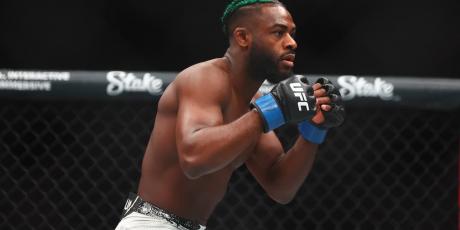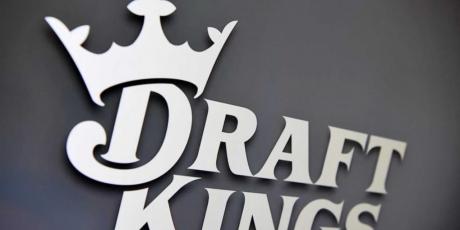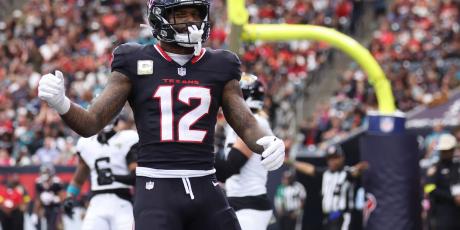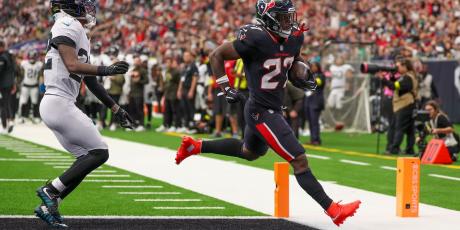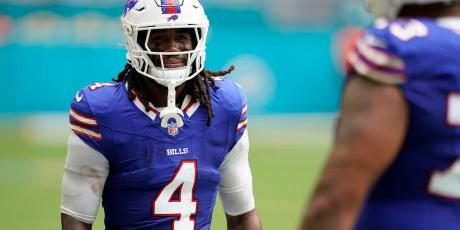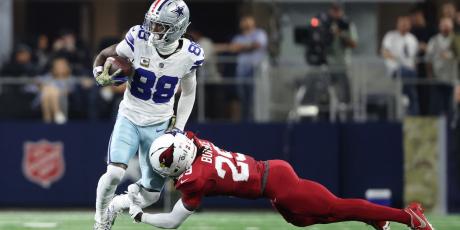Underdog Best Ball: How to Beat Weekly Winners
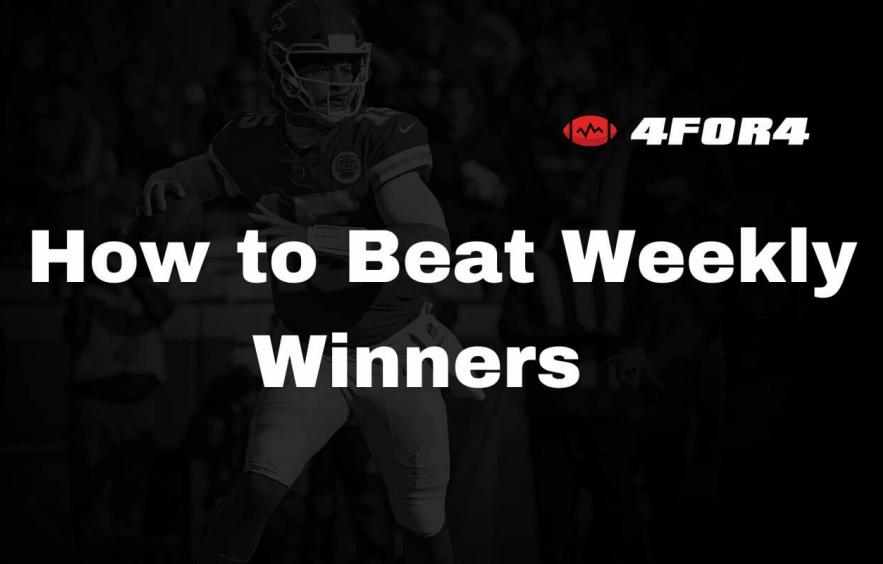
Best ball most frequently comes to us in large-scale tournaments with an initial regular season before progressing to the playoffs, akin to a traditional fantasy football league. Despite our focus on this format, other avenues exist to explore in the best ball space. Weekly Winners is a very young expansion on top of the game we love.
Instead of approaching the game as a series of successive tournaments, Weekly Winners is organized into 17 distinct tournaments your draft competes in each week. So if your lineup would have struggled in the regular season but explodes in the playoffs, you are still live to see large payoffs. Of course, like all large-scale tournaments, players should be weary of anticipating expected returns. Realizing your value will always require a long-timer horizon players are unlikely to meet.
The prospect of sweating your lineup every week certainly has captivated plenty of people as Underdog Fantasy's Weekly Winner contest projects to fill well before the season commences. For $10 players can have a shot at 20K each week.
Related: The Ultimate Underdog Best Ball Mania V Draft Guide
Along with the new tournament, also come new strategies. Players must recognize which aspects of traditional best ball continue to hold value and those that no longer apply. Adjusting back and forth can be difficult at times. Seeing Jonathon Brooks fall past his typical seven-eight turn spot, can be tantalizing. Despite the allure of another Brooks share, his ramp-up for his return from his ACL tear makes him a less valuable pick. Week 1 is equally as important as Week 17. Conversely, later in the year, Brooks’s disappointing weeks have not put you in a hole. Each week being a new tournament means drafters won’t be playing from behind but set on even footing
Admittedly my interest in Weekly Winners had waned from last year because I did not see massive success and the data was not released. Now, I'm left wishing I had gotten back in earlier. The puzzle of weekly winners is still so new that players are acting much more on vibes and theory than observed outcomes. Below I map out a little data and some takeaways from my dive into Weekly Winners. This is a partial list, and given the newness of the format, I could be swayed off of my opinions.
Stacking is a Must (don’t be afraid to double stack)
Stacking increases rosters reliance on a singular outcome. Correlating bets increases the frequency of tail outcomes. While teams may be more likely to fall on their face, the goal should always remain to hit the absolute pinnacle of performance at first. The first player paid out $1,000 or more is the 15th lineup out of 186,840.
The chart below highlights how frequently teams would have had at least one top-15 week broken down by year and number of stacked quarterbacks and the rows show the number of stacked pass catchers.
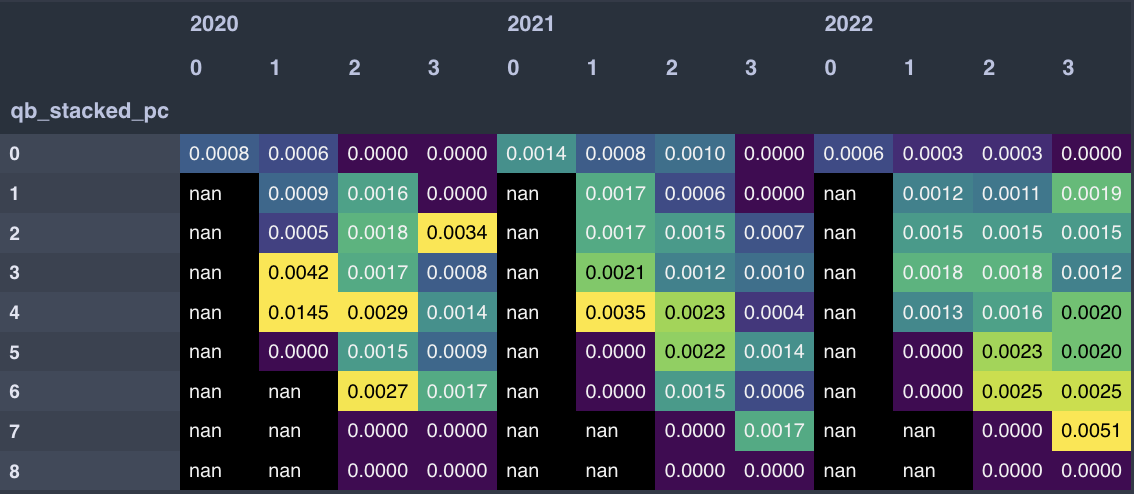
Perhaps this is different from the one Weekly Winner slate we’ve observed. That does not appear to be the case. There are of course considerations that go into this. When stacking condensed target trees or early-round picks, I would be less open to adding on additional pass catchers. Double stacks can prove fruitful though they are often not optimal. Even in a large-scale field like Weekly Winners the absolute optimal outcome is frequently not needed for the larger payouts. Only one of the stacking patterns or maybe two make it into the lineup but they provide more paths to victory.
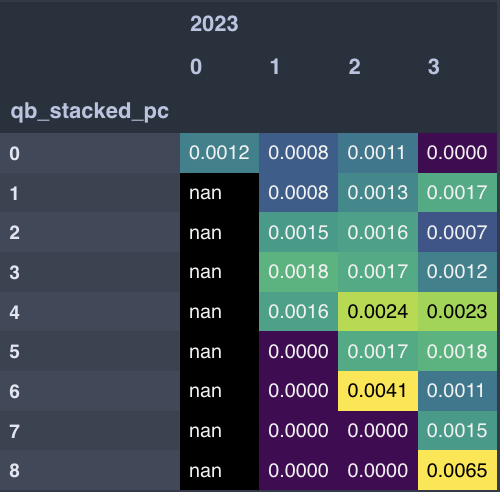
Related: How to Approach Quarterbacks in Best Ball
Time to REALLY Draft Like You’re Right
New players to best ball can overlook the importance of a floor outcome. Advancing teams often only make it that far because of a few small points throughout the year. Making balanced teams helps to ensure no zeros are taken. The replacement value at a team level is frequently only a few points as injuries and byes come into play.
Weekly Winners requires you to get all of that out of your head. Pay it the opposite way. Stacking byes can increase the number of live players for other weeks. If your first-round pick is injured for the year, sorry but this team is nearly worthless. While your initial picks do not HAVE to be on your weekly roster, playing as if they are locked in will help paint your path to the promised land. Looking at the top 500 rosters* from BBM I, II, and III highlights the importance of the early rounds.

Beware of trying to thread a needle that is too small. Stopping at one quarterback, one tight end, or three running backs severely limits the number of possible roster combinations available to that team. Even on plenty of early quarterback teams, opting for a second stack typically benefits the team. In my mind, there is a meaningful difference between an A.J. Brown + Jalen Hurts stack vs. Michael Pittman Jr. + Anthony Richardson. The cost of the quarterback may be relatively close, but tying your stack to a first-round pick increases your reliance on that hitting as getting the right first-round pick is nearly a necessity. For the Richardson stack, missing a third-round pick, while not ideal, is workable. Adding on other stacking options adds additional optionality to cover more Richardson paths to victory with one team. This is also more viable for pocket-passing quarterbacks, double stacks can make the winning lineups.
For the ultra-observant, it is not a rounding error that the used percentage does not add up to the nine roster spots filled each week. Some of the top-performing teams took zeros.
Related: How to Balance Running Back and Wide Receivers in Best Ball
Get Your Schedule Out
Game stacks are discussed frequently as levers for the playoffs and Week 17 specifically in typical best ball tournaments. In Weekly Winners, you need to have this mindset for every week. Once you select a few players, consider focusing on one week. The impact of focusing on one week is heightened for bye weeks, as byes weaken opposing rosters.
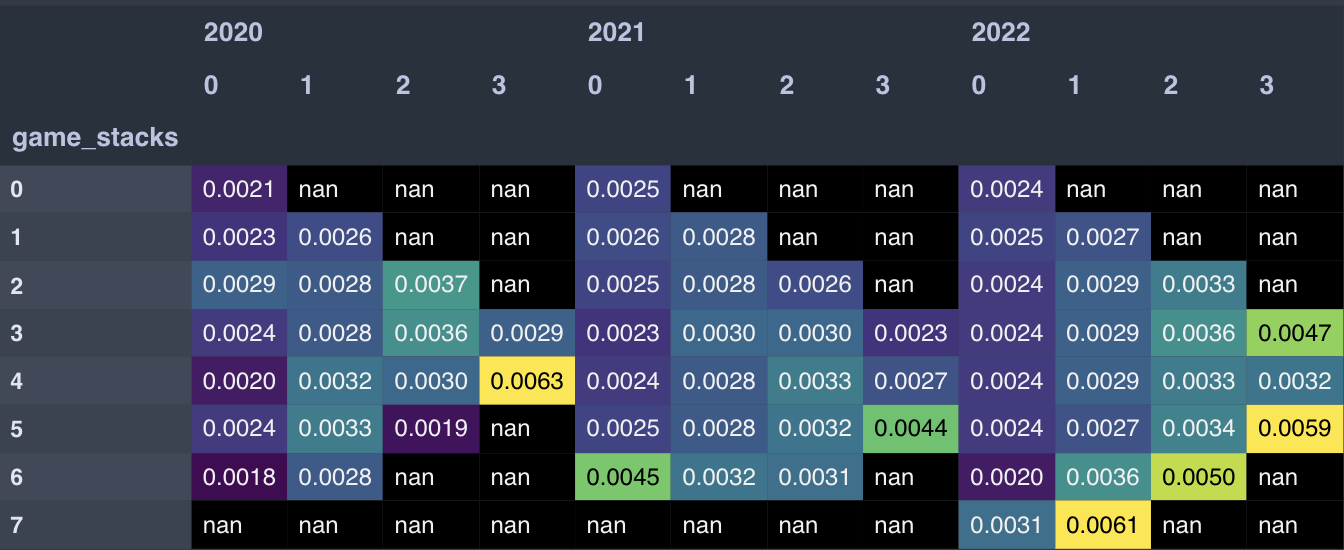
A similar pattern appears for teams in last year’s Weekly Winners tournament. Based on these charts the additional game stacks do not seem to move the needle much. While there are higher values the lower you go, that could easily be due to having more active players than higher entries. I am aiming for these minor stacks but not at all costs.
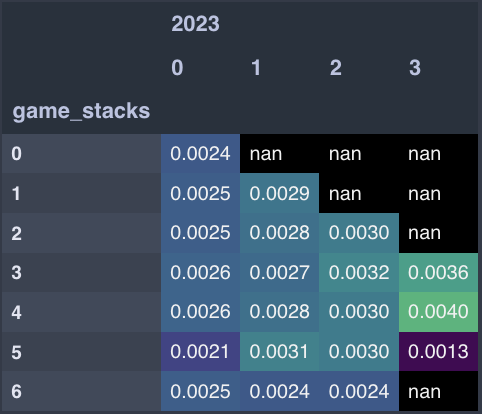
Get your schedule out and check who makes sense as a stacking option for your targeted week(s). Below is a look at a spreadsheet I use when drafting. The sheet has additional information highlighting potential teams to add, but for the most part, I operate almost entirely off of the schedule view. Dark purple highlights correlation with a top-five pick on my team, light purple spotlights correlation with a non-top-five pick, and gold denotes correlation with one of my quarterbacks. If you want to grind the maximum number of cents out of each draft, drafting these in front of your computer is necessary. Weekly Winners can still be fun to draft without taking it this seriously though.
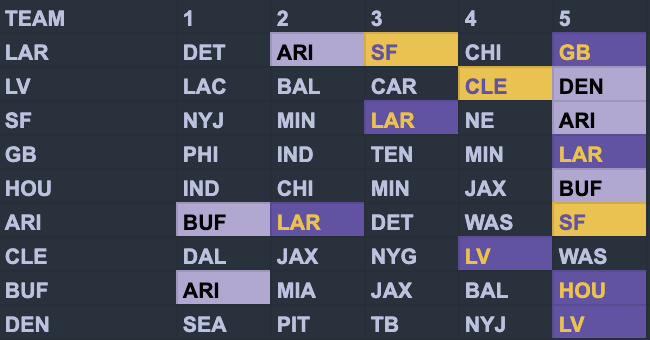
Related: NFL Schedule Release: Weeks 15-17 Targets for Best Ball Tournaments
Time to Gal-Brain
We have very little information arming us when entering a Weekly Winners draft. When conducting my “research” for this article, most of my time was spent looking at data for a completely different tournament format. Use radical structures that may not play well elsewhere. Do you find yourself forging toward a zero-RB team? Lean into this construction by stopping at five wide receivers!
ADP will matter in any tournament format but it is less important here than in others. We are not stacking our benefits throughout the season. The Weekly Winner ADP correlated slightly more with a team’s best finish than BBM ADP did last year.

A topic I frequently push back against is the importance of ownership and combinatorics. People overstate the leverage you build by creating infrequent combinations or taking seldom-drafted players. This tournament is the exact opposite. Instead of being sequestered into your little pod for each tournament stage, you are thrown into the pit and forced to fend off all aggressors.
I’ve cited the ownership of players going into the playoffs and highlighted that even considering the heightened ownership, that star player is likely the best option. Weekly Winners pits you against all other entries at once. Each early-round player will show up 15,570 times. Taking a combination of players that projects marginally worse but is taken together 5% less frequently, would result in nearly 800 fewer teams you’re competing with if those are the players you need that week. In this same vein, you want to consider your previously drafted teams even more. Taking similar combinations of players eats into your theoretical EV as your teams compete for a similar piece of the pie.
Taking low ownership plays to this point does provide drafters with leverage over the field. Late-round picks are unlikely to contribute in a big way to your lineup but if you’re taking a skill position player consider scrolling down.
Some selections at this point in the season include:
- QB: Bo Nix (207.0 ADP), Sam Darnold (215.0), and Aidan O'Connell (215.6). They may not offer a massive upside but could provide a good week at low ownership. All other viable QBs carry ownership
- RB: Trey Sermon (215.2), Samaje Perine (215.9), Will Shipley (210.0), and Deneric Prince (207.9)
- WR: Andrei Iosivas (202.9), Jalin Hyatt (212.8), Treylon Burks (213.6), Odell Beckham Jr. (214.3), Elijah Moore (214.5), Josh Reynolds (215.1), Kendrick Bourne (215.5), Ray-Ray McCloud III (215.7), Mack Hollins (215.8), and Daurice Fountain (215.9)
- TE: Colby Parkinson (208.8), Theo Johnson (213.2), Zach Ertz (214.6), Tucker Kraft (215.0), and Tommy Tremble (216.0)
The above lists are not exhaustive. These players will come in owned much less frequently than players at the same position with a slightly earlier ADP.
One of my semi-legitimate gripes with this game offering is the roster restrictions. To prevent more players from ruining drafts, Underdog implemented roster limits that you cannot exceed. While this makes some sense in traditional best ball, this is the Wild West, I came here to be a true gunslinger. Let me shoot from the hip like I’m robbing a stagecoach. If I start with two running backs, a tight end, and a quarterback, I should be allowed to draft more than 10 wide receivers in my next 14 picks. Is this optimal, probably not, but that doesn’t mean it shouldn’t be allowed.
Think for Yourself
Whereas best ball has a glut of work available for vibes players, numbers players, and anything in between, little data work exists on Weekly Winners. It is much more common to find players operating based on vibes than any sort of research. Take a minute to harness your inner Aaron Rodgers and think for yourself. Consider possibilities and what your optimal roster might resemble. People playing this exactly like a BBM are playing incorrectly. The one thing I am confident about in Weekly Winners is there’s a considerable amount of dead money. Starting A.J. Brown, Saquon Barkley, and Jalen Hurts paints a very narrow and unlikely path to victory. Season-long correlation is not your friend when we’re only looking at weekly outcomes.
How you break down the data matters significantly when looking at these tournaments. Other people have opted for slightly different approaches that can lead to meaningfully different results from mine. Neither approach is objectively correct, each has its own merits. While I may have qualms with other methods, thinking critically about the tournament should only make you a better player. There are many more ways to research this topic and questions I have not addressed to my satisfaction. We’re operating in a new realm where the guidelines for success have not yet been clearly defined.
Related: How to Approach Underdog 3-Team Best Ball Drafts
Let it Rip
I’m going to continue looking into Weekly Winners a little more. Time permitting, I will be entering a wild amount of these drafts in the next couple of weeks. Given the current outlook, my life may involve a ton of slows for the next couple of weeks. If you’re interested in asking questions or checking out any streams of me doing this, follow me on Twitter where I will post about it. For your other best ball needs, subscribe to 4for4 for all the content we have planned for the next month.
*top 500 rosters are not exactly the top 500 rosters. Each tournament has a different number of rosters, so top 500 refers to the percentile outcome required to be a top 500 roster for this year’s weekly winners tournament. 500/186,840
**Michael Chiang scraped and posted the Weekly Winners data from last year on his site bet.dev. The file available when I downloaded the data only had about two-thirds of the entries so that is the extent of last year’s data used.


